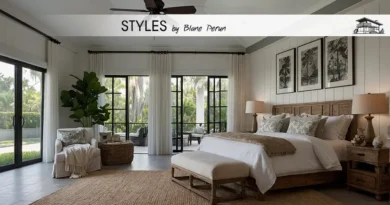Scandinavian Style
Embracing Simplicity: The Art of Scandinavian Interior Design
In a world where the clamor for maximalism seems to be everywhere, Scandinavian Interior Design stands out as a breath of fresh air. Rooted in the principles of minimalism, functionality, and a deep connection to the natural world, this design philosophy hails from the Nordic countries—Sweden, Denmark, Norway, Finland, and Iceland. It’s a style characterized by simplicity, understated elegance, and a harmonious balance between form and function. The ethos of Scandinavian design goes beyond mere aesthetics; it’s about enhancing the quality of daily life. It champions the idea that beautiful and functional homes are not reserved for the few but are accessible to all.

The Foundations of Nordic Aesthetics
The Palette of Nature: Colors and Textures
In Scandinavian Interior Design, the color palette draws heavily from the natural landscapes of the Nordic regions. Think of the soft hues of a foggy morning in Stockholm or the earthy tones of a Finnish forest. These interiors often feature a base of neutral colors—whites, grays, and blacks—accentuated with pops of colors inspired by the aurora borealis or the vibrant greens of Nordic flora. The use of natural materials like wood (often pine, ash, or beech), wool, and linen not only adds texture but also brings a piece of nature indoors, reinforcing the connection between the outside world and interior spaces.
Light: The Heartbeat of Scandinavian Design
Given the long winters and short days in the Nordic countries, light—both natural and artificial—is a central component of Scandinavian interior design. The goal is to create bright, airy spaces that counteract the darkness outside. Large windows, often left undressed or with minimal treatments, invite natural light in, while innovative lighting solutions ensure that homes remain warm and inviting, even during the darkest months. Reflective surfaces and strategic placement of mirrors also play a crucial role in maximizing light, making spaces appear larger and more open.
The Art of Functional Spaces
Minimalism Meets Practicality
Scandinavian interiors are the epitome of minimalism, but not at the expense of comfort and practicality. Every piece of furniture and decor is chosen with care, ensuring it serves a purpose beyond mere aesthetics. The design is intentional, with clean lines and simple forms that eliminate unnecessary clutter. This approach not only creates more breathable living spaces but also emphasizes the beauty of each individual piece, whether it’s a classic mid-century chair or a contemporary light fixture.
Sustainable and Eco-friendly Choices
Sustainability is at the core of Scandinavian design philosophy. There is a strong emphasis on eco-friendly materials and practices, from the use of renewable resources like wood and wool to the incorporation of energy-efficient technologies. Scandinavian design often involves pieces that are durable and timeless, encouraging a culture of quality over quantity. This mindful approach not only minimizes environmental impact but also resonates with the growing global consciousness towards sustainability.
The Personal Touch: Accents and Elements
Integrating Personal and Cultural Elements
While Scandinavian design may seem uniform, personalization plays a crucial role in bringing warmth and character to spaces. This could be through the incorporation of family heirlooms, local art, or even small, colorful accents that reflect personal tastes. The idea is to create a space that feels lived-in and cozy, reflecting the individual’s personality while maintaining the clean, minimalist aesthetic that defines Scandinavian design.
The Role of Textiles and Patterns
Textiles and patterns, while used sparingly, are essential in adding depth and warmth to Scandinavian interiors. Soft furnishings like cushions, throws, and rugs are not just functional; they’re also a way to introduce texture and subtle patterns into the space. Geometric patterns, inspired by traditional Nordic crafts, add a touch of complexity and interest, often serving as focal points in an otherwise minimalist room.
In embracing Scandinavian Interior Design, one embarks on a journey towards simplicity, functionality, and an innate connection with nature. This design philosophy not only enhances the aesthetics of a space but also improves the quality of life, proving that less can indeed be more.

FAQs on Scandinavian Interior Design
What defines Scandinavian Interior Design?
Scandinavian Interior Design is characterized by its simplicity, functionality, and connection to nature. This design philosophy emphasizes minimalist layouts, natural light, and the use of eco-friendly materials. It’s about creating spaces that are aesthetically pleasing yet practical and sustainable.
How do colors influence Scandinavian Interior Design?
Colors play a vital role in Scandinavian design, with a palette that often includes whites, grays, blacks, and blues, reflecting the natural landscapes of the Nordic regions. These colors, combined with strategic pops of brighter hues, create a sense of balance and harmony within the space.
Why is light so important in Scandinavian interiors?
Given the Nordic countries’ long winters and limited daylight, light is crucial in Scandinavian interiors to create a sense of warmth and openness. Large windows, reflective surfaces, and strategic lighting solutions are used to maximize natural and artificial light, making spaces appear larger and more welcoming.
Can Scandinavian Interior Design be personalized?
Absolutely. While Scandinavian design values minimalism and functionality, personal touches are encouraged to add warmth and character. This can be through art, textiles, or even personal mementos, ensuring the space reflects the individual’s personality while maintaining a cohesive design aesthetic.
How does Scandinavian Interior Design incorporate sustainability?
Sustainability is a cornerstone of Scandinavian design, with a focus on using renewable resources, eco-friendly materials, and sustainable practices. This ethos not only minimizes environmental impact but also aligns with the global shift towards more conscious living and consumption.





